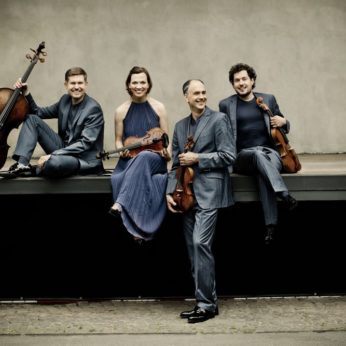Composer: Joseph Haydn (b. 1732 - d. 1809)
Performance date: 27/06/2022
Venue: St. Brendan’s Church
Duration: 00:23:28
Recording Engineer: Simon Cullen, Ergodos
Instrumentation: 2vn, va, vc
Instrumentation Category:String Quartet
Artists:
Signum Quartet (Florian Donderer, Annette Walther [violins], Xandi van Dijk [viola], Thomas Schmitz [cello]) -
[String Quartet]

Joseph Haydn [1732-1809]
String Quartet in F minor Op.20/5
1. Moderato
2. Minuet and Trio
3. Adagio
4. Finale; fuga a due soggetti
This is the darker of the two minor key works in Opus 20. Haydn probably wrote it before the G minor quartet. If any of these quartets deserve to be linked to the Strum und Drang (Storm and Stress) movement, this would be the one. In fact most of the literary works of the movement were published after Haydn completed these quartets although it is possible that he was influenced by the atmosphere they were reflecting.
We know that Haydn liked to escape to Vienna as he wrote a symphony about it. The greatest symphony of this period, the “Farewell” was composed in the same year as the Opus 20 quartets. It is extremely likely that on his infrequent trips to Vienna, Haydn heard the operas of Gluck (1714 -1787). Gluck’s tragic operas of the 1760s played a major role in the musical part of the Sturm und Drang movement. It is striking that several of the highly emotional slow movements in Opus 20 take a form very similar to an operatic aria.
The first movement opens with a mournful melody which dominates the movement. The second main theme, which is introduced by a brief semi quaver passage on the cello. Its dotted rhythms give the music a haunting character. It plays little role in the development but makes up a large part of the coda. The vigorous development modulates through a number of keys; A flat, E flat minor, F minor, C minor. The return to the recapitulation is marked by three downward triplets on the first violin.
The main theme is further developed in a passage of considerable emotional turmoil. After repeating the whole movement in two parts, Haydn adds a harmonically adventurous coda before a subdued conclusion. The Minuet manages to be both sad and elegant. The playful Trio in F major brings a brief moment of warmth and charm.
The slow movement is a dance which has been called a Siciliana. For most of the movement the violin weaves an intricate accompaniment of semiquavers above the other instruments which keep to the distinctive Sicilian rhythm. Above one of the longest passages of violin decoration Haydn writes per figurem retardationis. A well known English music critic asked the great nineteenth century violinist Joseph Joachim what this meant. He replied it means that the figures of the violin are always a step behind the chords; it must be played dreamily and tenderly.
The Finale is one of the three final movements in Opus 20 which are fugues. This one is based on two short themes. The first begins the movement, played by the second violin. It is a theme often used for fugues during the baroque period and even makes an appearance in Handel’s Messiah. The second theme, which is Haydn’s own, is introduced by the viola two bars later. In this movement Haydn shows his mastery of contrapuntal technique. All four instruments play equal roles. The themes are split up, turned upside down and continually passed from one instrument to another. Haydn concludes with a canon between the first violin and the cello of both themes in turn. The Finale is the only movement of the Quartet that ends with a confident cadence played forte.
David Winter
Copyright © 2025 West Cork Music. All rights reserved.
Designed and developed by Matrix Internet